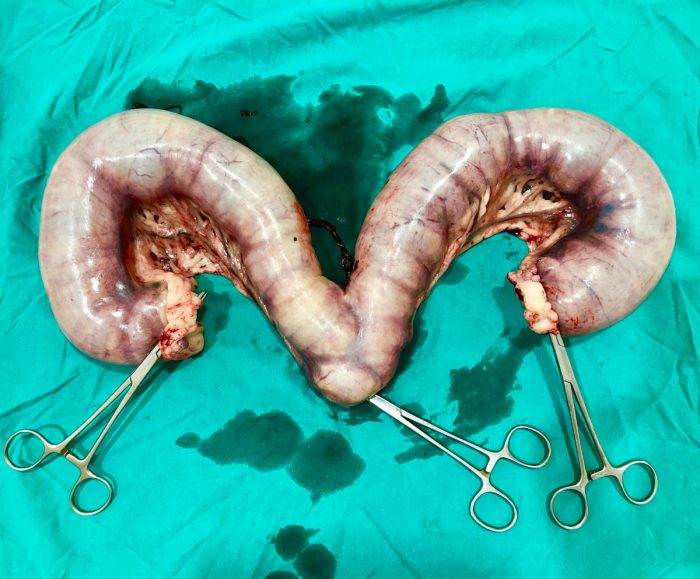At a glanceWhat is pyometra? Pyometra is a bacterial infection of the cat’s uterus. Causes: Repeated heat cycles in which the cat does not become pregnant. Symptoms:
Treatment: Surgical removal of the uterus and ovaries, antibiotic therapy and supportive care. |
What is pyometra?

Pyometra (which means pus-filled uterus) is a serious and life-threatening bacterial infection of the uterus that is associated with a condition known as cystic endometrial hyperplasia (CEH). It used to be thought that female cats were induced ovulators, meaning ovulation occurs when the cat mates, however, it is now believed that the female ovulates spontaneously (without mating) and several ovulations may have occurred without the owner being aware.
Normally if no pregnancy occurs, the lining will regress at the end of the heat cycle, however, frequent heat cycles, spontaneous ovulation and administration of progestins (used to control heat cycles in cats) may result in abnormal endometrial growth. In this situation, prolonged exposure to progesterone results in hyperplasia (enlargement) of the endometrium and causes the endometrium glands to become cystic. Other influencing factors such as the inhibition of myometrial (uterine wall) contractions, closed cervix, decreased white blood cell activity can all create an ideal environment for bacteria to grow. The most common pathogens are E. coli, streptococcus, and staphylococcus.
Pyometra can occur in any unspayed female, however, there is a higher incidence in middle-aged cats over five years of age. Most cases of pyometra occur within 60 days of the female being in estrus.
How does bacteria get into the uterus?
Normally the cervix remains tightly closed, however, when the cat is in heat, the cervix opens to allow the male cat’s sperm to enter.
Symptoms of pyometra in cats?
Pyometra usually appears 6 – 8 weeks after the queen goes out of heat. It is a life-threatening infection and requires immediate veterinary attention. Pyometra may come on quickly, or take several months to fully develop.
There are two types of pyometra, open and closed.
- Open pyometra: The cervix is open, and the pus drains out of the vagina. This is often cream, pink or brown in colour, and has an offensive odour.
- Closed pyometra: As the uterus is closed, the pus is unable to drain from the vagina and therefore collects in the uterus.
All cases of pyometra are a medical emergency, however, closed pyometra is far more dangerous and life-threatening. Both forms of pyometra require immediate veterinary attention. Pyometra can lead to organ damage and septicemia.
As well as the possible discharge from the vagina, your cat may display some or all of the below symptoms:
- Anorexia (loss of appetite)
- Weight loss
- Lethargy
- Fever
- Normal, increased or decreased body temperature
- Excessive thirst and urination
- Distended abdomen
- Abdominal pain
- Dehydration
- Panting
Diagnosis
Your veterinarian will perform a physical examination of your cat and ask for a medical history such as when her last heat cycle was. During the examination, the veterinarian may be able to feel the enlarged uterus and see discharge from the vagina.
Diagnostic workup:
Baseline tests: Biochemical profile and complete blood count may reveal azotemia (elevation of blood urea nitrogen), hyperproteinemia (elevated levels of protein in the blood), hyperglobulinemia (elevated globulin concentration) and increased number of band neutrophils.
Ultrasound can confirm the diagnosis which will reveal an enlarged fluid-filled uterus and confirm a lack of pregnancy.
How is feline pyometra treated?
- Ovariohysterectomy (desexing/spaying) is the best option, which involves surgical removal of the infected uterus and ovaries while the cat is under general anesthetic.
- Antibiotics to control the infection. Where possible, culture the pus so that the cat can receive the most effective antibiotics. The most common antibiotics used to treat pyometra in cats are amoxicillin-clavulanate, or a combination of penicillin and fluoroquinolone.
- IV fluids to treat dehydration and correct electrolyte abnormalities.
If the cat is required for breeding, prostaglandin treatment may be attempted. This causes the uterus to contract and the cervix to relax, to assist in the evacuation of the pus. There may be side effects from the prostaglandin such as vomiting, diarrhea, restlessness, panting, shock. There is a chance that treatment will not be successful, and for pyometra to reoccur in cats treated for pyometra but not spayed.
Prevention
Pyometra is 100% preventable by spaying females.
Pyometra FAQHow long can a cat live with pyometra? Not long, pyometra is a life-threatening infection. The toxic effects of the bacteria will lead to organ failure. The uterus can also rupture, leading to infection of the abdominal cavity (peritonitis). Is it possible to treat pyometra in cats at home? No, pyometra always requires veterinary attention which almost always requires surgical removal of the infected uterus, antibiotic therapy and supportive care. What colour is pyometra discharge: Discharge is foul-smelling and is usually cream, pink or brown. Is pyometra in cats contagious: No, pyometra is not contagious to cats other people. What to expect after pyometra surgery in cats: The cat will be sent home with oral antibiotics. |

